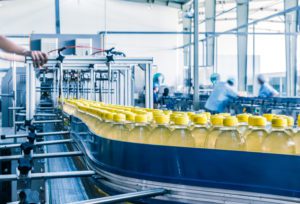Improve Manufacturing Efficiency and Productivity in 3 Simple Steps
While COVID-19 vaccinations are making their way across more and more of the population, it will be a long time before manufacturing plant operations go back to normal – and there’s no doubt that many of the changes forced by the pandemic will be permanent. In managing a plant, you’re likely juggling multiple priorities: keeping workers safe, dealing with market fluctuations and adapting to consumer demand.
By recognizing how the pandemic and other outside factors negatively impacted efficiency and productivity goals, you can take steps to ensure your operations remain optimized when the next disaster hits.
Manufacturing Efficiency and Productivity: The Challenge
Manage Unsafe Industrial Manufacturing Environments
During a pandemic, worker safety must be top of mind, especially for those working in close physical proximity to one another. However, there are many touchpoints between workers on the plant floor when it comes to collaboration and shift hand-overs – how can you safeguard against COVID-19 in these conditions? How can you avoid changeover delays, while still trying to keep people physically distanced? Does collaboration suffer because of social distancing?
Operate With Leaner Teams
COVID-19 is a contributing factor to many of the workforce issues that impact the plant floor today, chief among them being leaner and smaller teams. First, with shifts in product popularity and consumer needs, plant profitability is one of the first places to take a hit. This then creates a domino effect: budget cuts that lead to furloughs or lay-offs, resulting in shrinking teams tasked with running a plant, often at full capacity. Couple that with a challenge that preceded COVID-19 – a retiring manufacturing workforce – and you might now be looking at lean teams that also lack institutional knowledge of manufacturing processes.
Industrial Production Mistakes and Inefficiencies
A new working environment, with fewer staff to rely on and more pressure than ever to turn a profit and maximize productivity, is a recipe for disaster. This confluence of events means that inconsistencies and mistakes in work execution are not only at greater risk, but are also more likely to occur. Ensuring appropriate training, proper work execution and compliance becomes a significant hurdle to overcome, especially in a fast-moving and uncertain environment. Additionally, limited visibility into plant operations, which you may have been able to work around prior to the pandemic, now become a bigger barrier to success.
Improve Manufacturing Efficiency and Productivity With These 3 Steps
What steps can you take on your factory floor today to boost both manufacturing efficiency and productivity, to overcome challenges brought on by the pandemic? The first rule of thumb when tackling efficiency and productivity challenges in manufacturing is to recognize that people are your best asset on the plant floor, and mobile technology enables your team to accurately and efficiently get work done. When you combine them, that’s when the magic happens. The relationship between frontline workers and technology is what ultimately drives greater manufacturing efficiency and productivity.
Here are three steps you can take to overcome these challenges:
1. Mobile Inspections Provide More Guidance
Humans still perform 72% of frontline work. People, not machines, are the driving force behind manufacturing production. While automation is a critical component of a well-run factory, it works best when it enhances human capabilities.
Machines bring predictability to production, but people bring critical thinking and decision-making, every day.
Digital technology that connects humans with other workers, systems and machines, is central to creating a plant environment that can better support productivity.
One of the best ways to leverage Connected Worker® from Parsable is to provide more guidance to your workers. In a busy manufacturing environment, individual guidance and worker training is not only a challenge for plant managers faced with time constraints, but is also a resource drain. That doesn’t, however, make giving guidance any less important – it may just be the difference between how you can successfully and efficiently run your plant.
Connected Worker enables you to provide workers with dynamic, digitized standard operating procedures (SOPs) through a mobile app to help them execute their work correctly, the first time and every time.
SOPs offer step-by-step guidance, and visual cues, across every process to ensure that your frontline workers are able to move through their tasks with accuracy, speed and safety, and it gives you the ability to get the most out of both your workers and the machines they’re operating on.
Digitized SOPs can also provide in-app checklists and training materials for task completion, ensuring all the appropriate steps are taken across every process, to avoid any potential issues down the road, like a piece of equipment or machinery consistently being mishandled that could lead to a malfunction. Additionally, unlike paper procedures that plants have historically relied upon, digital work instructions have the added benefit of being very adaptable – you can change the content at any moment to reflect updated SOPs or production guidelines. This is something that is happening more often during the pandemic, as manufacturing companies are required to pivot, time and time again, to meet the most pressing product needs.
Guidance is everything when it comes to better supporting your workers in their day-to-day tasks and actions. Everyone needs a helping hand and guardrails for safety, especially when they might be doing the work of two or three people on a leaner plant floor team.
2. Digital Work Instructions Enable More Visibility
Having instant visibility into all operations is every plant manager’s dream, right? Well, with Connected Worker that is now possible. You have the opportunity to get a bird’s-eye view of operations that they so desperately seek when tackling manufacturing efficiency and productivity challenges. The beauty of connecting workers digitally to manufacturing operations, is that you have a record of human activity data that ultimately leads to more insight into production processes.
With that data you can understand, what’s working well and what’s not? Are there roadblocks or inefficiencies you cannot see with the naked eye? Why is production line A moving at half the pace of production line B, when both lines are making the same product? Without the insight that technology captures, insight that manual, paper-based operating procedures certainly would not, it would be nearly impossible to answer these questions.
Without more visibility and workforce data, it’s impossible to know where to begin to address issues, or lags and problems in production. Managing plant issues blindly is never the way to truly solve inefficiencies. Perhaps even more importantly, increased visibility enables you and your leadership to react and adapt to unexpected disruptions, such as: changes in demand, disruptions in the supply chain and updated COVID-19 safety regulations. Agility in manufacturing is essential as teams continue to navigate an uncertain world, with possibly less people power on the plant floor.
3. Improve Communication and Collaboration Among Your Team
Good communication and consistent collaboration are everything when it comes to increasing efficiencies. Connected Worker is a quick implementation, and it can elevate the amount and level of collaboration on your factory floor, even amid a social-distanced reality. For example, with Connected Worker technology your team can share photos and videos of in-progress processes with colleagues and industry experts, for extra guidance. This gives people instant access to other teammates, strengthening the overall speed of the feedback loop. It also enables people to stay socially distant while working or doing shift changeovers, keeping them safe.
Instant collaboration helps to solve problems rapidly, boosting manufacturing efficiency and productivity across every aspect of operations.
Once you’ve implemented the three steps above to create a more efficient and productive manufacturing plant environment, the next step is to measure its impact. Impact is ultimately the ratio of outputs to inputs – can you actually do more with less?
With the right talent and digital tools, the answer is yes!





